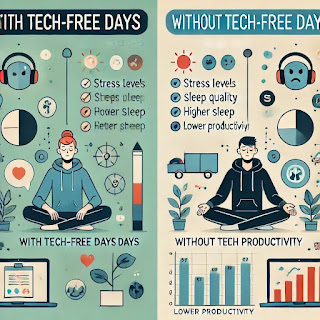Digital Detox 2.0: Embracing 'Tech-Free' Days for Mental Health in a Hyperconnected World
In today’s digital age, where screens and social media dominate our daily lives, taking intentional time away from technology has become more than a luxury—it’s a necessity. Digital Detox 2.0 introduces the concept of "tech-free" days to reset, recharge, and reclaim mental peace. In this article, we’ll explore why a tech-free day is trending, its mental health benefits, how to plan one, and tips to make it successful.
Introduction to Digital Detox 2.0
With the average adult spending up to 7 hours per day on screens, many are finding themselves overwhelmed, fatigued, and craving an escape from constant connectivity. Digital Detox 2.0 is about creating intentional, tech-free days—spaces to unwind, rediscover offline activities, and regain a sense of balance. Unlike traditional detoxes that ask us to “unplug” entirely, this approach is about reclaiming mental peace by scheduling regular intervals of tech freedom.
 |
| Person enjoying , embracing a tech-free day |
Why We Need Tech-Free Days
Modern technology keeps us connected 24/7, but this connection often comes at the cost of mental well-being. Notifications, social media, and the pressure to always be available can lead to:
- Anxiety and stress: Constantly checking devices can create feelings of overwhelm and stress.
- Sleep disturbances: Screen exposure, especially before bed, negatively impacts sleep quality.
- Reduced productivity: The frequent interruptions from notifications hinder focus and deep work.
 |
| Infographic showing benefits of tech-free days for mental health and productivity |
A tech-free day allows us to disconnect, which has benefits beyond just mental peace. It helps build intentionality, letting us reconnect with ourselves and our loved ones.
Mental Health Benefits of Digital Detox
Improved Focus and Concentration
When we eliminate screen distractions, we can focus better on activities, be it reading a book, engaging in conversation, or doing creative work. Studies have shown that regular tech breaks can help improve memory and concentration.Better Sleep Quality
Cutting down on screen time, especially before bed, improves sleep quality. The absence of blue light exposure encourages natural melatonin production, leading to deeper and more restorative sleep.
 |
| Minimalist bedroom setup with no screens, representing improved sleep through digital detox. |
Enhanced Relationships
Unplugging provides more quality time with loved ones. Without digital distractions, relationships can deepen, as we become fully present in conversations and shared activities.
How to Plan a Successful Tech-Free Day
Planning is essential for making a tech-free day a success. Here’s a quick guide to help you get started:
Select the Right Day
Start with a weekend day or any day when tech isn’t critical to your responsibilities. Plan it on a day where you can indulge in relaxing offline activities.
 |
| Cozy reading nook setup for a tech-free day |
Notify Friends and Family
Inform those close to you about your planned digital detox so they’re aware you won’t be reachable. This removes the pressure to check in or feel guilty for being unavailable.Schedule Tech-Free Activities
Prepare offline activities to fill your day: reading, cooking, gardening, painting, hiking, or any hobby that brings joy. Having these activities ready will help reduce the temptation to reach for a screen.Create a Designated Tech-Free Space
Make a small tech-free area in your home, like a reading nook, where no devices are allowed. This physical boundary helps reinforce the digital detox mindset.
Tools and Tips for an Effective Digital Detox
Airplane Mode
Enable airplane mode on your devices to avoid interruptions. This allows access to essential phone functions like alarms without being disturbed by notifications.Go Analog
Consider using non-digital alternatives. Swap digital planners for physical notebooks, use printed books instead of e-readers, or try an analog alarm clock. This shift not only supports a tech-free day but encourages mindfulness.
 |
| Analog clock and journal for an offline, tech-free morning routine |
Set Boundaries for Tech-Free Days
Schedule regular tech-free days based on your needs. Some people benefit from weekly tech-free days, while others might prefer monthly breaks.
Real-Life Success Stories
Real-life stories can provide motivation for anyone trying a tech-free day:
Maria, the Busy Professional: Maria, a project manager, felt overwhelmed by constant emails and notifications. She dedicated Saturdays as her tech-free day and has noticed less stress and improved focus during the workweek.
 |
| people enjoying creative activities during tech-free days |
Sam, the Artist: For Sam, a freelance artist, tech-free Sundays became a source of creative rejuvenation. His artwork and productivity have flourished as he devotes one day a week to creative activities without any digital interference.
These stories show how even one day away from tech can recharge and inspire, making us more productive, creative, and present.
Finding Balance in the Digital Era
A digital detox isn’t about rejecting technology altogether but about finding a healthy balance. By integrating tech-free days, we become more mindful about our screen habits and can experience improved mental well-being, focus, and even sleep. Starting with just one tech-free day a month and observing the benefits can inspire you to continue and even increase the frequency.
If you’ve tried a tech-free day, share your experience! How did it impact your mood, productivity, or creativity? Let us know in the comments!




No comments:
Post a Comment